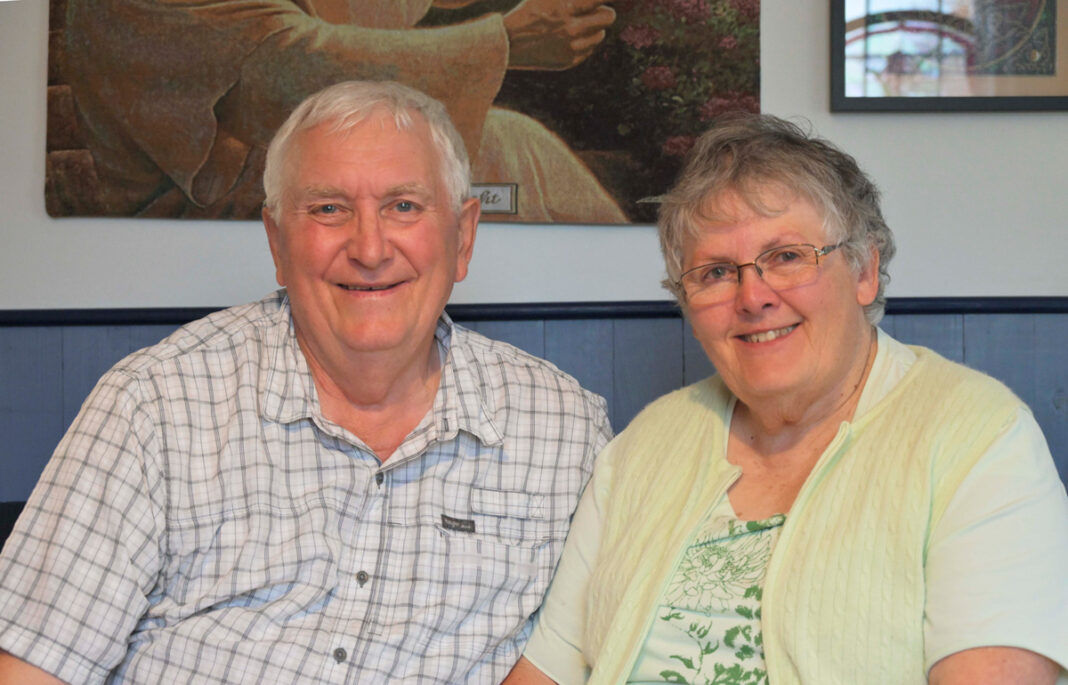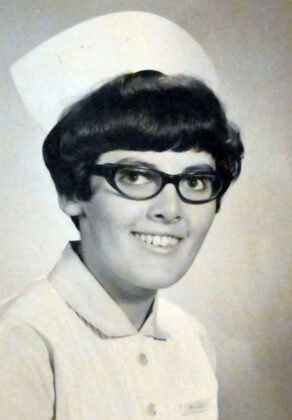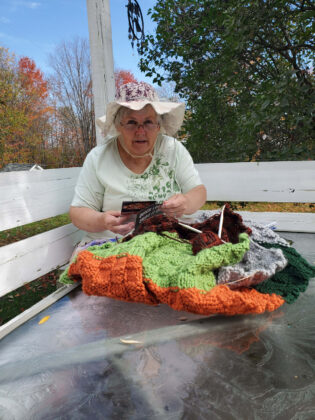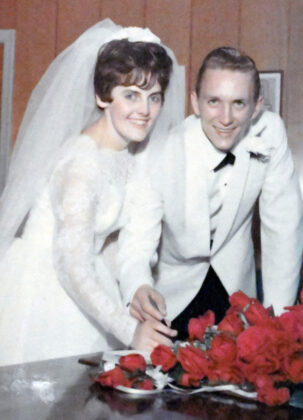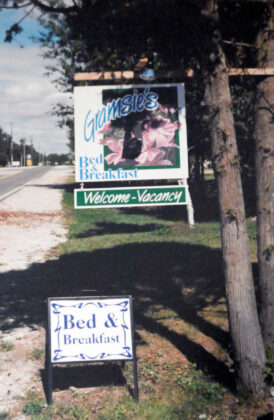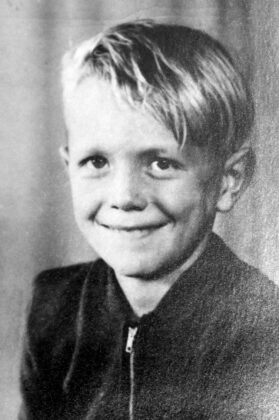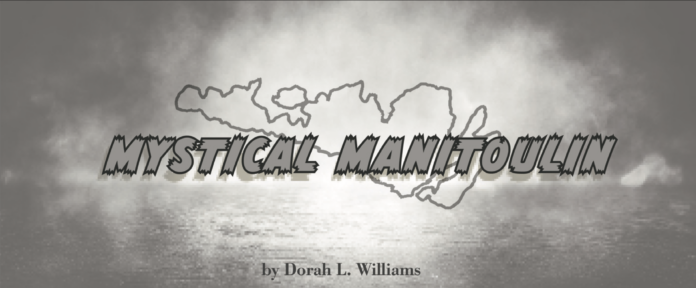Ed and Shirley Sagle
These two talented and remarkably busy history buffs live comfortably among two dozen Muscovy ducks and a few deer nestled among the fall trees that bear their coats of many colours today. A bunkie displaying the sign of their previous bed and breakfast accommodations in South Baymouth, a sizable workshop and a duck coop add ambience to the idyllic colourful fall scene. Their home, built in the late 1800s, boasts many historic elements, including the narrow floorboards, wainscoting and numerous antiques. It is a comfortable setting that welcomes the writer. Tea and tasty cookies are served. Both Ed and Shirley have gathered numerous details about their ancestors, and they have been vital members of the Church of Jesus Christ Of Latter-Day Saints where they have volunteered their services for many years. Ed was also a driving force for the creation of the Michael’s Bay Historical Society and the organization’s rejuvenation plan for the old townsite.
“My paternal great-grandfather, John Robert William Thompson, born in 1833, left Ireland and worked on the railroad in Scotland before moving to the United States with his wife Sarah Ann Bell and seven children,” Shirley begins. Two more daughters were born in Pennsylvania where John worked at a lime kiln. Their fourth son James became my grandfather. He stayed with the family after his brothers had moved out. The family moved north to Muskoka and in 1981, John, 48, died when a tree fell on him. Son James was a quiet man who farmed and grew strawberries in the Muskoka area. He married Jane Cairns from Uffington, Ontario. They had seven children and my dad was the sixth child. Jane quilted, raised chickens, cared for farm animals and preserved fruits and vegetables. She had a strong affiliation with both the Anglican and Presbyterian faiths.”
“Maternal grandfather was George William Smith of Surrey, England. He was a blacksmith who served in the Boer War. His wife, Grace May Yarrow was born in Glen Miller, Ontario. The Smiths had fruit orchards. A horse and buggy would get Grace to the local market gardens and when her horse grew tired of the task, the family truck was assigned. They had nine children. My mother Edith May Smith was born early, on December 31, 1917, weighing about two pounds. Her mother placed her in a box on the oven door to keep her warm. She was the smallest child but lived to be 94.”
Shirley was born to Edith and Gordon Thompson on January 25, 1949, in the Red Cross Hospital in New Liskeard. “My father, born in 1905, served in World War Two and was away when I was born. We didn’t have a phone so mother had asked her neighbour to watch for a specific item to be hung on the laundry line when she was ready to give birth and that did the trick.” Shirley, the eldest, would have two sisters, Mary and Gloria and two brothers, James and Brian. “If I behaved, I remember getting a pint of chocolate milk from the milkman several times a week. We always left the correct change on the top of the milk bottle lid. When brother James was born, we moved to the Long Lake area of Sudbury. Father was a carpenter and he built us a house on Fourier Avenue in the valley. Dad also fashioned homemade skis one year, and they were well-used.”
“Picking berries was a yearly task. We loved to eat them, but many raspberries, strawberries and blueberries were also canned. When we had time, we would walk the two miles to Witson Lake and go swimming,” Shirley shares, “On a more serious note, I once helped my sister avoid a possible abduction. I was just coming around the corner of the house in time to see a car stop at the end of our driveway. A man was offering candy to my little sister Gloria. I quickly intervened and got her back to the house. it was lucky that I had been in the right place at the right time.”
Regular chores for Shirley at 12, in addition to ironing, were scrubbing and waxing the floors. “Buying groceries with dad taught me to budget well, with the cash I had. I knew what the family needed for the next two weeks but had to prioritize and make sure I didn’t exceed our available funds. I was also a candy striper in the geriatric wing of the Memorial Hospital. We helped with the meals, wrote letters, provided fresh water and paid welcomed visits.”
Shirley recalls winning a contest to name the new public school she attended. “I was proud that they chose my suggestion, ‘Valley View Public School.’ I remember having to give a speech and being so very nervous. I did get an award, a pen with my name on it. When I graduated from Grade 8, my teacher said, ‘don’t let your artistic skills die.’ I didn’t. I have enjoyed various artistic projects over the years, including working with watercolours with nine of my 11 grandchildren.”
“I liked going to La Salle Secondary School. Biology was my favourite. I met Ed on a blind date in Grade 12. I remember telling the mother of my friend, Judy Brown, that I was nervous about this date. She reassured me that ‘you never know, this person might be the man you marry.’ Six of us went to the movies. My first impression of him was a little subdued due to the cold Ed had, but he was genuinely nice, and he was tall. We soon hit it off and dated for the next five months. This was followed by going steady for five months and finally with our five-months engagement.”
Ed and his ancestors hailed from the Manitoulin area. “I have researched 15 generations of my family, with the earliest record going back to 1520,” Ed begins, “that date belonged to Wilfred Temple, of Yorkshire, England, on my mother’s side. Moving up to 1803, we have my paternal great-great-great-grandfather Henry Sagle and his wife, Susanna, both of whom lived in King Township, York County. Henry’s family was one of only 33 families living there at that time. Great-great grandfather Peter Sagle married Abigale Morris, both farmers in King Township. One of their seven offspring was Thomas Sagle, my great-grandfather who was born in 1832 in King Township. He married Elizabeth Rhyndress and had 11 children when they moved to Manitoulin in 1879. He died in 1897 and is buried in Hilly Grove Cemetery. Their son David John Sagle, my grandfather, was born in 1861 in Grey County.”
“Grandfather David cleared the land in the Slash and farmed. He married Annie Isabella Sim, born in 1868. Her father Robert Sim had emigrated from Scotland. Annie’s grandmother, Hannah Still, had been married to Joe Ritchie. After he was killed in Montreal, she married Robert Sim. David and Annie also had 11 children. Annie looked after her neighbourhood as well as her family. The land they owned, and their large home, are still in the Sagle family. Grandfather died of a stroke at 66, in 1927. It is noteworthy that a Sim reunion was held this August for the five offspring of Robert Sim.”
“My mother is Margaret Sandie, originally ‘Sandy’ for her grandfather’s generation. She was born in 1909 in Thessalon to George and Wretha (Kerr) Sandie, also Scottish. Margaret was one of four children. Her grandfather James had been a stone mason in Fergus, where his name is still on a plaque of the historical building he built and lived in. James also worked on the Welland Canal. George built the high school and many houses in Thessalon after a fire destroyed part of the town. Margaret married my dad David John Sagle in 1931 in Thessalon. Margaret’s father bought a gas station and corner store when he retired. I recall grandmother saying, ‘George, don’t give the kids a lot of candy when you take them to the store.’ Nevertheless, when we got to the store, he declared, ‘take as much candy as you like.’ We were in heaven.”
“I was the eighth child of 11 children in our family. I had five brothers and five sisters. Jean and Wayne are both deceased now. Joyce and Ken are also deceased. Then there is Anne, Eileen who has died, Calvin, me, Maxine, Terry and Dale. I was born on February 8, 1947, in Mindemoya, the first born in a hospital, when it was named the Red Cross Hospital. Mother was temporarily staying in Nevill’s boarding house. When her time came, she walked across the street to the hospital. She told us earlier, when Wayne had been born at home, the doctor from Manitowaning had not been allowed upstairs, because he was inebriated. Aunt Betty Sagle, midwife, delivered most of the older children.”
“I remember our house burning down when I was four. My older sister Jean saved me. She ran back in when she noticed I wasn’t standing outside with the family. She dragged me out from under the bed. We could see the flames beside the chimney when we were heading out. It had been a narrow escape. We lived near grandmother’s house and could stay there while father, a logger at that time, built us a new home.”
“Our one-room school was at SS#7, but attending was not my favourite pastime. I did like history and math. Ruby Coultis, our teacher, wound up instructing all my siblings over time. Grade 8 was held in SS#3 school. High school was in Mindemoya where the public school is now. On weekends, I helped dad cut wood for shipping and for the stove. Work in the summers included helping local farmers with odd jobs, like picking the unwanted mustard plants growing in oat fields.”
“It was my plan to quit school after Grade 10 to work for a year at INCO. I made $1.97 per hour for surface work and $2.19 underground, which later became $2.37. Instead of returning to school, I bought my first car, a 1966 Volkswagen, with $2,800 cash. My brother and I also bought 100 acres for $600 in the Lower Slash Road. I raised chickens, ducks, pigs, geese and guinea hens.” When Ed met Shirley, plans began to include them both.
The wedding was held on June 22, 1968, at the Church of Ascension on Sparks Street in New Sudbury. About 100 people attended the dinner and dance at Carol Richard Park Hall in the Valley. “One Grade 13 friend played the organ, and another was our photographer,” Shirley adds. “The honeymoon took us to Ottawa, Upper Canada Village, Niagara Falls and Hamilton where my sister lived. We had no credit cards and needed cash so had to go to a bank that was willing to call our Sudbury bank and forward cash during the trip. “We certainly had a wonderful time.”
That September, the couple moved into a small apartment on Londsdale Avenue. Shirley enrolled in a nursing assistant program in 1968 and the RN training at the Regional School of Nursing in 1969. “They wanted me to stay home for six months to get used to married life.” After the training was completed, Shirley was hired at the General Hospital. “Our first home in 1971 was on Greg’s Lane. It was 400 sq ft, and the lot was 120 ft deep by 30 ft wide and both cost $10,000. Prize roses decorated the front. We added a basement and spent seven wonderful years in that Italian neighbourhood.” Over time, the couple had three sons, John, Don and Scott.
In June of 1977, they bought a 1,500 sq. ft house in the Valley. We played T-ball with the boys. Our oldest son later played in a Little League championship in Timmins and Quebec. Both Ed and Shirley were still active in the church, and they spent 15 years with the Boy Scouts. Shirley nursed and volunteered three times a week, at the Family History Centre Library for the Church of Jesus Christ of Latter Day Saints. “It was fun to get to know people who were searching for their ancestors in the microfiche and films.” Ed was a pastor in the church, for seven years in Sudbury and later, 20 years in Little Current.
When Ed retired as a trainer of new recruits from INCO in 1997, the couple moved to the Island. Ed and Shirley had transformed a home in South Baymouth into ‘Gramsie’s (Shirley’s grandma’s name) Bed and Breakfast.’ Ed was on council for Tehkummah Township for eight years and a first responder for the Tehkummah ambulance and fire for 15 years. He became the curator of the South Baymouth Museum. Ed and Brian Gleason were also the founding members of the Michael’s Bay Historical Society. Anita March, Esther Spadzinski and Dorothy Duncan, government representatives, were on the committee that drove the idea forward to protect the Michael’s Bay townsite and the five graveyards. “One-hundred and fifty people came to the Tehkummah Hall to support this initiative. It was an exciting meeting. We were happy that others felt this was important too.”
“It took us 20 years to move the Michael’s Bay initiative forward with the Island and the government. The government only required us to pay $7,500, including legal fees, to get the 30 hectares but it took us all winter that year to negotiate the purchase. The Biosphere owns the land around the town site. Eventually, we hope to make the property a tourist attraction with much of the town rebuilt, including the blacksmith shop, the general store, the school, and the mill. It could be peopled with summer students to represent our first settlers, many of whom are buried in Michael’s Bay. We hope to make the rejuvenation project a tourist attraction.”
Were you named after anyone? “Edgar Kerr on mother’s side. A cousin of Dad’s sister was Shirley.”
Most important event in your life? “Our wedding and the birth of our children. Other key events were becoming church members with leadership and teaching roles starting in 1978, teaching Sunday School and being a president of the Relief Society, a long-established women’s organization. Lastly being a Women’s Organization counsellor to encourage the love for the Saviour, as a way of life for every day, not just Sundays.”
Favourite pets? “Our huskie-border collie mix, a rescue dog named Shadow. She seemed to know she was rescued. She loved our ducks and the local deer.”
Favourite season? “Spring and fall. In spring we would tap 97 maples, get barrels of sap and this year, 85 liters of syrup. We also have a heritage apple orchard that must be pruned and picked. We now have honey boxes and are awaiting an inspection to start gathering honey. In spring and fall, our trees are so beautiful. It’s nice to see the daffodils and crocuses pop through the snow in spring. We celebrate Thanksgiving in the beautiful log home in the Slash where our son lives. Fall is also time for travel.”
Hobbies? “The sawmill on the property gives me lots to do and I love it,” Ed offers. “The front deck was cut from logs that came from an 1884 barn in the Green Bush area.” Shirley loves to play with recipes, paint with watercolours, and make memory or comfort quilts out of old materials like flannel pajamas.
What are your strengths? Shirley claims effective communication, being perceptive, also knitting, sewing, and quilting. Ed is compassionate, works well with wood, and children are attracted to him. Both have spent time teaching grandchildren how to make book bags, paint and bake. The children also learned to tap, prune or saw trees. Lastly, they know how to recognize trees, even those that are partially dead.
Anything you still want to do? “Write a cookbook and make photo albums of our family histories.”
What did you enjoy most as a parent? “The exciting adventures that we had with the boys. In 2012, I was part of 95 bus loads of high school kids and grandfathers that travelled overseas. I took Thomas, our oldest grandson. We spent a week travelling to Vimy Ridge for their 95th anniversary. While there, we went to Amsterdam, Vimy Ridge, Juno Beach and Parkindale. All the students spent over an hour in the rain listening to the sensitive talk and nobody complained. It was a very emotionally rewarding experience. We also checked out the Eiffel Tower in Paris.”
Recipe for happiness? “Love and effective communication.”
“Our son Don, in Sudbury, is also interested in our family histories. Both Don and Scott work for a government data centre. John owns his own business, Diversified Naval Architects in Dowling. They do ultrasounds on boats.”
Grandchildren? “We love them: Kayla, Thomas, Brianna, Celine, Kyle, Peter, Steven, Harrison, Jordan, Robert and Charlotte and four great-grandchildren: Riley, Bailey, Aurelia and Oakley.”
“Manitoulin has so much beauty and serenity. Before moving here, I wanted to stay in Sudbury, my hometown, and where my mother still lived, but Manitoulin is Ed’s home and after being here, this is now my home too. I worked for VON on the Island and started the bed and breakfast, enjoying the interesting visitors from all over the world. For Ed, he has come back home to his ancestral home.”
Ed adds, “I left at 18 and at 50, felt a calling to be back here and now I am happy as a clerk in my church and working with the Michael’s Bay Historical Society. The church has been so important to both of us. Now the children love this place as much as we do. We will reside here among the ducks, the trees, and the Manitoulin ambience and we will be here for the rest of our lives.”
Favourite verse: “Be Thou humble, and the lord, thy God, will lead thee by thy hand and give answers to thy prayers.”
by Petra Wall

